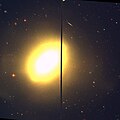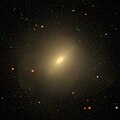NGC 3610
| NGC 3610 | |
|---|---|
 Hubble Space Telescope image of NGC 3610, showing its disk | |
| Observation data (J2000 epoch) | |
| Constellation | Ursa Major |
| Right ascension | 11h 18m 25.276s[1] |
| Declination | +58° 47′ 10.49″[1] |
| Redshift | 0.005694[2] |
| Heliocentric radial velocity | 1,732 km/s[3] |
| Galactocentric velocity | 1,819 km/s[3] |
| Distance | 106 Mly (32.5 Mpc)[4] |
| Apparent magnitude (B) | 11.63[3] |
| Characteristics | |
| Type | E5:[2] |
| Mass | 1.01×1011 (stellar)[4] M☉ |
| Size | 76,800 ly (23,560 pc)[2] |
| Apparent size (V) | 1.460′ × 1.168′[1] (NIR) |
| Other designations | |
| NGC 3610, UGC 6319, LEDA 34566, PGC 34566[5] | |
NGC 3610 is an elliptical galaxy in the constellation Ursa Major.[6] It was discovered on 8 April 1793 by German-British astronomer William Herschel.[7] This galaxy is located at a distance of 106 million light-years (32.5 Mpc) from the Milky Way,[4] and is receding with a galacto-centric radial velocity of 1,819 km/s.[3]
NGC 3610 is a relatively young elliptical galaxy which has not yet lost its disk.[6] It has a morphological classification of E5,[8] indicating a 2:1 ratio between the major and minor axes of the elliptical profile. This is a candidate merger remnant of intermediate age, with a surviving disk of gas and dusk aligned with the major axis.[9] This merger is estimated to have occurred 4±2.5 Gyr ago. The central part of the disk displays warping,[8] and is significantly younger than the remainder of the galaxy.[8]
The unusual amount of blue light emission of NGC 3610, or B–V in the UBV photometric system, suggests recent star formation.[9] The current estimated star formation rate is 0.385±0.375 M☉·yr−1.[4] There is a population of younger globular clusters orbiting the galaxy that is a likely product of the merger. The surviving population of older, metal-rich globular clusters suggests that at least one of the progenitor galaxies had a prominent bulge component.[9]
Gallery
-
 NGC 3610 by Hubble Space Telescope
NGC 3610 by Hubble Space Telescope -
 NGC 3610 (SDSS DR14)
NGC 3610 (SDSS DR14)
References
- ^ a b c Skrutskie, Michael F.; et al. (1 February 2006). "The Two Micron All Sky Survey (2MASS)". The Astronomical Journal. 131 (2): 1163–1183. Bibcode:2006AJ....131.1163S. doi:10.1086/498708. ISSN 0004-6256. S2CID 18913331.
- ^ a b c "Results for NGC 252". NASA/IPAC Extragalactic Database. Retrieved 12 February 2017.
- ^ a b c d Tully, R. Brent; et al. (2016). "Cosmicflows-3". The Astronomical Journal. 152 (2). id. 50. arXiv:1605.01765. Bibcode:2016AJ....152...50T. doi:10.3847/0004-6256/152/2/50. S2CID 250737862.
- ^ a b c d Lianou, S.; et al. (November 2019). "Dust properties and star formation of approximately a thousand local galaxies". Astronomy & Astrophysics. 631. id. A38. arXiv:1906.02712. Bibcode:2019A&A...631A..38L. doi:10.1051/0004-6361/201834553.
- ^ "NGC 3610". SIMBAD. Centre de données astronomiques de Strasbourg. Retrieved 12 February 2017.
- ^ a b "A young elliptical". Hubble Space Telescope. Retrieved 16 December 2016.
- ^ Seligman, Courtney. "NGC 3610 (= PGC 34566)". cseligman. Retrieved 12 February 2017.
- ^ a b c Buson, L. M. (September 2010). "The mid-UV population of the nucleus and the bulk of the post-merger NGC 3610". Astronomy and Astrophysics. 519. id. A59. arXiv:1008.0922. Bibcode:2010A&A...519A..59B. doi:10.1051/0004-6361/201014429.
- ^ a b c Howell, Justin H.; et al. (December 2004). "Probing Spectral Line Gradients beyond One Effective Radius in NGC 3610". The Astronomical Journal. 128 (6): 2749–2757. arXiv:astro-ph/0409385. Bibcode:2004AJ....128.2749H. doi:10.1086/425884.
Further reading
- Bassino, Lilia P.; Caso, Juan P. (April 2017). "The merger remnant NGC 3610 and its globular cluster system: a large-scale study". Monthly Notices of the Royal Astronomical Society. 466 (4): 4259–4271. arXiv:1701.02056. Bibcode:2017MNRAS.466.4259B. doi:10.1093/mnras/stw3390.
- Goudfrooij, Paul; et al. (June 2007). "Dynamical Evolution of Globular Cluster Systems Formed in Galaxy Mergers: Deep Hubble Space Telescope Advanced Camera for Surveys Imaging of Old and Intermediate-Age Globular Clusters in NGC 3610". The Astronomical Journal. 133 (6): 2737–2751. arXiv:astro-ph/0702467. Bibcode:2007AJ....133.2737G. doi:10.1086/516634.
- Strader, Jay; et al. (January 2004). "Revisiting the Globular Cluster System of the Merger Remnant Elliptical Galaxy NGC 3610". The Astronomical Journal. 127 (1): 295–301. arXiv:astro-ph/0310611. Bibcode:2004AJ....127..295S. doi:10.1086/380614.
- Strader, Jay; et al. (February 2003). "Keck Spectroscopy of Globular Clusters in the Elliptical Galaxy NGC 3610". The Astronomical Journal. 125 (2): 626–633. arXiv:astro-ph/0211156. Bibcode:2003AJ....125..626S. doi:10.1086/346086.
- Whitmore, Bradley C.; et al. (July 2002). "The Luminosity Functions of Old and Intermediate-Age Globular Clusters in NGC 3610". The Astronomical Journal. 124 (1): 147–157. arXiv:astro-ph/0205001. Bibcode:2002AJ....124..147W. doi:10.1086/340808.
- Fabbiano, G.; Schweizer, Francois (July 1995). "ROSAT PSPC Observations of Two Dynamically Young Elliptical Galaxies: NGC 4125 and NGC 3610". Astrophysical Journal. 447: 572. Bibcode:1995ApJ...447..572F. doi:10.1086/175900.
- Scorza, C.; Bender, R. (August 1990). "A disk in the elliptical galaxy NGC 3610". Astronomy and Astrophysics. 235: 49. Bibcode:1990A&A...235...49S.
External links
 Media related to NGC 3610 at Wikimedia Commons
Media related to NGC 3610 at Wikimedia Commons
- v
- t
- e
- 3500
- 3501
- 3502
- 3503
- 3504
- 3505
- 3506
- 3507
- 3508
- 3509
- 3510
- 3511
- 3512
- 3513
- 3514
- 3515
- 3516
- 3517
- 3518
- 3519
- 3520
- 3521
- 3522
- 3523
- 3524
- 3525
- 3526
- 3527
- 3528
- 3529
- 3530
- 3531
- 3532
- 3533
- 3534
- 3535
- 3536
- 3537
- 3538
- 3539
- 3540
- 3541
- 3542
- 3543
- 3544
- 3545
- 3546
- 3547
- 3548
- 3549
- 3550
- 3551
- 3552
- 3553
- 3554
- 3555
- 3556
- 3557
- 3558
- 3559
- 3560
- 3561
- 3562
- 3563
- 3564
- 3565
- 3566
- 3567
- 3568
- 3569
- 3570
- 3571
- 3572
- 3573
- 3574
- 3575
- 3576
- 3577
- 3578
- 3579
- 3580
- 3581
- 3582
- 3583
- 3584
- 3585
- 3586
- 3587
- 3588
- 3589
- 3590
- 3591
- 3592
- 3593
- 3594
- 3595
- 3596
- 3597
- 3598
- 3599
- 3600
- 3601
- 3602
- 3603
- 3604
- 3605
- 3606
- 3607
- 3608
- 3609
- 3610
- 3611
- 3612
- 3613
- 3614
- 3615
- 3616
- 3617
- 3618
- 3619
- 3620
- 3621
- 3622
- 3623
- 3624
- 3625
- 3626
- 3627
- 3628
- 3629
- 3630
- 3631
- 3632
- 3633
- 3634
- 3635
- 3636
- 3637
- 3638
- 3639
- 3640
- 3641
- 3642
- 3643
- 3644
- 3645
- 3646
- 3647
- 3648
- 3649
- 3650
- 3651
- 3652
- 3653
- 3654
- 3655
- 3656
- 3657
- 3658
- 3659
- 3660
- 3661
- 3662
- 3663
- 3664
- 3665
- 3666
- 3667
- 3668
- 3669
- 3670
- 3671
- 3672
- 3673
- 3674
- 3675
- 3676
- 3677
- 3678
- 3679
- 3680
- 3681
- 3682
- 3683
- 3684
- 3685
- 3686
- 3687
- 3688
- 3689
- 3690
- 3691
- 3692
- 3693
- 3694
- 3695
- 3696
- 3697
- 3698
- 3699
- 3700
- 3701
- 3702
- 3703
- 3704
- 3705
- 3706
- 3707
- 3708
- 3709
- 3710
- 3711
- 3712
- 3713
- 3714
- 3715
- 3716
- 3717
- 3718
- 3719
- 3720
- 3721
- 3722
- 3723
- 3724
- 3725
- 3726
- 3727
- 3728
- 3729
- 3730
- 3731
- 3732
- 3733
- 3734
- 3735
- 3736
- 3737
- 3738
- 3739
- 3740
- 3741
- 3742
- 3743
- 3744
- 3745
- 3746
- 3747
- 3748
- 3749
- 3750
- 3751
- 3752
- 3753
- 3754
- 3755
- 3756
- 3757
- 3758
- 3759
- 3760
- 3761
- 3762
- 3763
- 3764
- 3765
- 3766
- 3767
- 3768
- 3769
- 3770
- 3771
- 3772
- 3773
- 3774
- 3775
- 3776
- 3777
- 3778
- 3779
- 3780
- 3781
- 3782
- 3783
- 3784
- 3785
- 3786
- 3787
- 3788
- 3789
- 3790
- 3791
- 3792
- 3793
- 3794
- 3795
- 3796
- 3797
- 3798
- 3799
- 3800
- 3801
- 3802
- 3803
- 3804
- 3805
- 3806
- 3807
- 3808
- 3809
- 3810
- 3811
- 3812
- 3813
- 3814
- 3815
- 3816
- 3817
- 3818
- 3819
- 3820
- 3821
- 3822
- 3823
- 3824
- 3825
- 3826
- 3827
- 3828
- 3829
- 3830
- 3831
- 3832
- 3833
- 3834
- 3835
- 3836
- 3837
- 3838
- 3839
- 3840
- 3841
- 3842
- 3843
- 3844
- 3845
- 3846
- 3847
- 3848
- 3849
- 3850
- 3851
- 3852
- 3853
- 3854
- 3855
- 3856
- 3857
- 3858
- 3859
- 3860
- 3861
- 3862
- 3863
- 3864
- 3865
- 3866
- 3867
- 3868
- 3869
- 3870
- 3871
- 3872
- 3873
- 3874
- 3875
- 3876
- 3877
- 3878
- 3879
- 3880
- 3881
- 3882
- 3883
- 3884
- 3885
- 3886
- 3887
- 3888
- 3889
- 3890
- 3891
- 3892
- 3893
- 3894
- 3895
- 3896
- 3897
- 3898
- 3899
- 3900
- 3901
- 3902
- 3903
- 3904
- 3905
- 3906
- 3907
- 3908
- 3909
- 3910
- 3911
- 3912
- 3913
- 3914
- 3915
- 3916
- 3917
- 3918
- 3919
- 3920
- 3921
- 3922
- 3923
- 3924
- 3925
- 3926
- 3927
- 3928
- 3929
- 3930
- 3931
- 3932
- 3933
- 3934
- 3935
- 3936
- 3937
- 3938
- 3939
- 3940
- 3941
- 3942
- 3943
- 3944
- 3945
- 3946
- 3947
- 3948
- 3949
- 3950
- 3951
- 3952
- 3953
- 3954
- 3955
- 3956
- 3957
- 3958
- 3959
- 3960
- 3961
- 3962
- 3963
- 3964
- 3965
- 3966
- 3967
- 3968
- 3969
- 3970
- 3971
- 3972
- 3973
- 3974
- 3975
- 3976
- 3977
- 3978
- 3979
- 3980
- 3981
- 3982
- 3983
- 3984
- 3985
- 3986
- 3987
- 3988
- 3989
- 3990
- 3991
- 3992
- 3993
- 3994
- 3995
- 3996
- 3997
- 3998
- 3999












